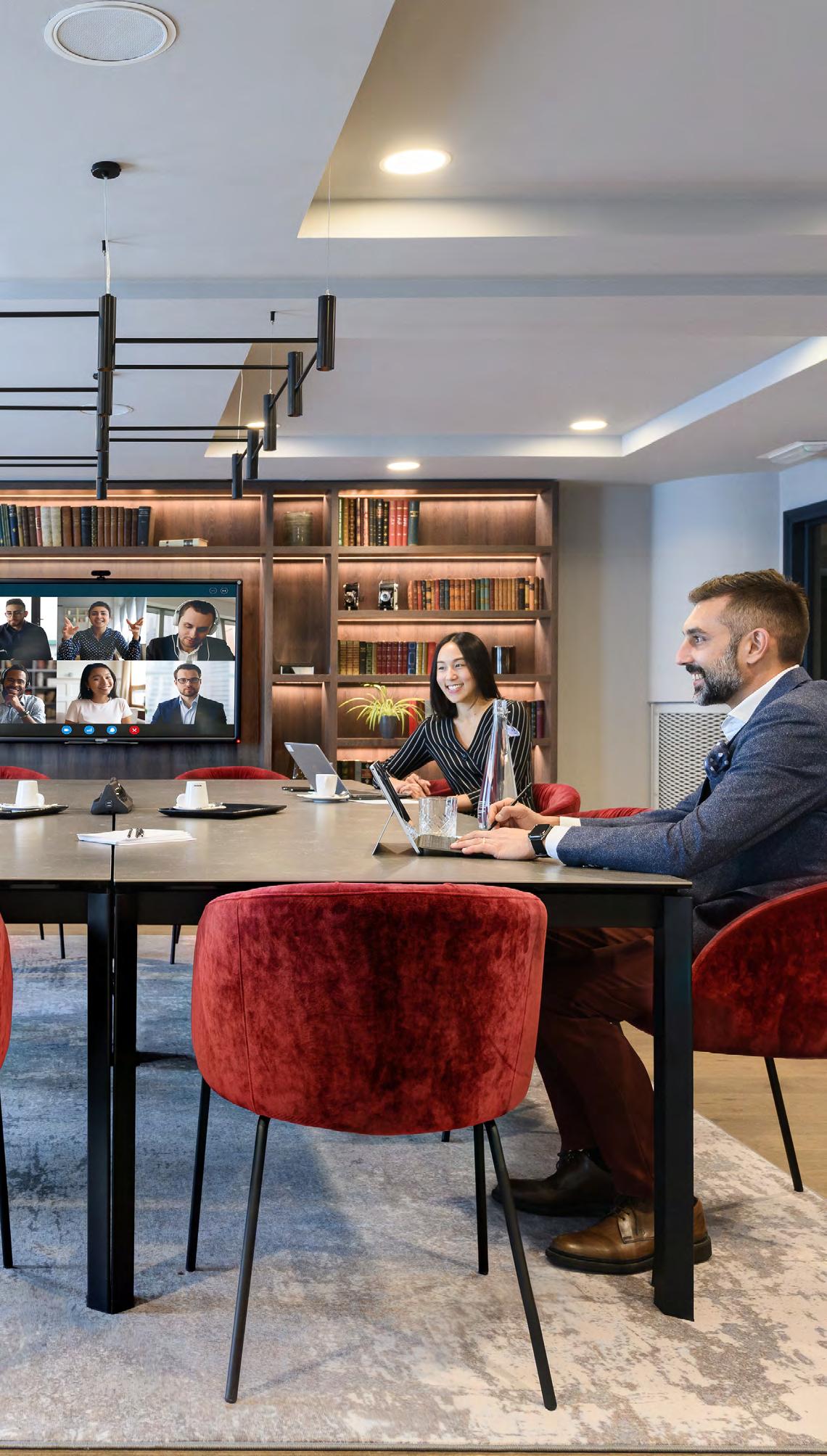
11 minute read
Return on Investment for Healthcare Sector Meetings and Events
Virtual Meetings Strategies
This discussion highlighted that assessing external and internal needs and measuring results were key pillars of a successful virtual meeting strategy. Understandably, companies were in different places in developing and deploying their strategies aligned to the appetite from meeting stakeholders, speakers and participants for “good, content driven” virtual interactions that are to become a permanent feature beyond the pandemic. It was felt that there are tools and partners in the marketplace, existing and in development, to deliver on these needs, with more technology innovation and smart use of channels to share this content. Channels included; the internal business structure; global > country and 2. with and via 3rd parties. Channel development supported the realisation of optimal content reach and “quality” engagement, often valued with in-person meetings, that have been largely unavailable due to the COVID19 pandemic.
Key Outcomes
Shared perspectives
• Demand for virtual meetings (VM’s) moving into 2021 shows no sign of reducing. In most cases demand is increasing as teams engage (centrally or in a fragmented way) to find / utilise / encouraged to access best practise. • Pace of VM’s implementation varies from company-to-company dependant on the longevity of their virtual meeting (digital strategies) programmes. • Measuring VM’s will be key for the future. • Content is key to select; formats, tools and overall approaches. • HCP and internal stakeholder need assessments is a critical part of defining the shape of the strategic and tactical focuses.
• A reduction in, in-person meetings demonstrated the opportunities for virtual to support sustainability programmes. • Hybrid meeting solutions will be a focus within virtual meeting strategies.
General Observations
• Utilisation of zoom as a platform, since early security issues, is increasing for some companies. • Shifting from an in-person to virtual focus has highlighted which, current meeting partners, understand and deliver on relationship. • Development of VM strategies can, in some case, be an almost classical change management situation with the techniques and approaches required in this scenario.
Key Statistics
Question: Post / living with COVID19 what % volume split do you think your organisation will have for face to face and virtual meetings, for both internal and external audiences?
Internal and external audiences
11%
11%
11%
56%
11%
10% F2F / 90% Virtual
25% F2F / 75% Virtual 40% F2F / 60% Virtual
50% F2F / 50% Virtual 60% F2F / 40% Virtual
75% F2F / 25% Virtual 90% F2F / 10% Virtual
67% of organisations believe they will have more f2f than virtual meetings after COVID19
22% of organisations believe they will have more virtual than f2f meetings after COVID19
Statistic Takeaway
a bias towards face-to-face meetings is balanced by the fact that virtual interactions have quickly gained favour, with a significant pre-COVID rise in future volumes.
Healthcare Procurement Hot Topics 2021
The focus topics of SMMP, business needs, and the future of hybrid format meetings were all discussed in depth during this webinar. Only three of the six polls used during the webinar received a majority vote of more than 50%, with one question splitting the votes 50-50. When the three responses with a percentage vote larger than 50% were removed, the average percentage distribution of votes was decreased to 16 percent. This fragmented picture suggests that, at least in the short and medium term, a return to meeting strategy design is the way forward for a large number of organisations as they deal with the change in meeting programmes caused by the COVID19 pandemic.
Key Statistics – Focus topic 2, Business Need
Poll: Which three business criteria is most important / relevant to your organisations approach to virtual meetings
5%
Uplift SMMP to include VM
5%
Reduce number of VM Suppliers
24%
Selection of approved virtual meeting platforms
25% 20% 15% 10%
5%
0%
14%
Understand longer term business needs for VM
10% Integrating /aligning IT functions
10% Gain Visibility on VM activity across the business
14%
Roll out best practise across the business
19%
Understanding of VM participant (HCP’s/ Internal) needs
Key Statistic Takeaway
The top votes in this poll to identify business needs were a focus on selecting virtual meeting platforms and understanding the needs of virtual meeting participants. The fact that votes were dispersed over a wide range of priorities may indicate how challenging it will be to rebuild meeting programmes in light of the COVID19 epidemic.
Key Outcomes
Focus topic 1 – SMMP:
Virtual meeting integration with SMMP has shown to be beneficial, as evidenced by a poll finding that 78 percent of businesses have taken efforts to reap the benefits of integration. Some of the issues cited were regional approaches, as well as the capability and resources of external support for those still struggling with the effects of the pandemic on their businesses. The benefits of SMMP were seen as having a strong return on investment (ROI) from data and having senior leadership listen to the benefits of SMMP.
Focus topic 2 – Business need:
In the poll dedicated to this focus topic, no single option received more than 19 percent of the vote. This suggests that organisations have a diverse set of priorities across the eight categories.
Focus topic 3 – Hybrid meetings:
86 percent of organisations are either preparing for or already have significant plans for hybrid meeting activities. Though the definition of a hybrid meeting can still be a point of discussion benefits were seen as contributing to sustainable meetings, providing flexible formats for participants. Ultimately cost benefit analyses will help define the success of hybrid programmes which can be seen as more time consuming over other formats.
Key Takeaway
The discussions revealed that healthcare and life science companies’ current meeting strategies vary significantly, with some at the early stages of developing new, post-Pandemic, meeting programmes and others more advanced, with significant hybrid meetings in the advanced stages of planning, having already adjusted SMMP solutions, implemented technology, and agency RFP results. As we observe the lockdown’s easing around the world, it’s safe to expect that re-tuning meeting programmes to integrate virtual and hybrid needs will take new thinking, time, and resources.
Sustainable Meetings: a priority conversation or a priority action?
Sustainability is now an established social as well as a business issue; it affects many aspects of our lives, from using paper cups to powering the pharmaceutical industry. With the topic gaining momentum, as evidenced by higher governmental, public and meeting participant expectations and many meetings opting to be sustainable, we discussed how advanced we were in creating sustainable meetings strategies. Meetings created and supported by healthcare and life science companies were in-scope. Our discussion process began with a pre-meeting survey.
Survey highlights:
• The topic was important to all organisations, with 25% believing they lacked a clear definition of sustainable meetings. • 3/10 organisations felt they had made progress toward their goal of sustainable meetings. 10% achieved their target of 50%. None believed they are more than 50% to target. • It was felt that participants’ decisions to attend a meeting were not yet significantly influenced by whether or not the meeting was sustainable.
Factors that contribute to sustainable meetings.
*Lower the score the higher the organisational priority
1st Reduced air travel
2nd Senior leadership buy in
3rd Use of green venues
4th Supplier capabilities e.g., intermediaries and venues
5th Appetite and understanding of meeting stakeholders
5th Less meetings and events
6th Carbon off setting of meetings
0
3.67
4.40
5.20
6.20
6.40
6.40
8.60 10 Key Statistics
We modelled a 2-night, 3-day investigator meeting, with the aid of carbon footprint measurement specialists event:decision, for 120 short and long haul participants to a kick off training meeting.
Graphic 1 shows the by % contribution of each segment of the meeting and its carbon footprint.
Materials 1
Energy 3 Transportation 0
Waste 2
Graphic 2 demonstrated the impact of air travel to this event, dominating the carbon footprint of this profile of meeting.
Accomodation 8 Energy 1
Catering 4 Transportation 0
Materials 0
Catering 19 Travel 37
Accomodation 38
Analysis by Event:decision
*Travel – not including flights or train travel to the meeting
Analysis by Event:decision
Key Takeaway
Air travel, specifically long-haul, has a dramatic impact on CO2 emissions. In meeting terms this is the single largest category which, if reduced, can significantly contribute to organisational sustainability targets.

Key Focus
To turn theory into practise is a challenge and a collaborative effort is required from senior leadership with clear mandates, informed meeting stakeholders who should consider sustainability as they plan the format of their meeting, intermediaries who are ahead of the sustainable meetings marketplace, software companies enhancing their core solutions and supplier partners who have embraced the topic in a turnkey manner. And, of course, participants and assessing their evolving expectations to participate in sustainable meetings. These actors’ roles must be supplemented by benchmark measurements for developing strategies and reporting models.
Key Outcomes
• The group had similar issues, including an overall lack of progress in the development and implementation of sustainable meeting strategies were identified across all organisations, particularly in Europe which was considered to be more advanced than the rest of the world. An aligned calculation and KPIs within the
Meetings and event strategy will support • There is an appetite for the topic without yet, reaching the senior leadership of most organisations. • Barriers include the perception that to be sustainable impacts the bottom line of a budget. • We can expect an accelerated definition of targets for sustainable meetings by companies. • There is no single focus for less meetings being the answer to the question of sustainable meetings.
Rather, a focus on benchmarking a meeting footprint, improved meeting approvals, and sophisticated reporting to understand the impact and opportunities for carbon reduction of single and multiple meetings. • Carbon offsetting is not seen as key to enable “staying the same” and has yet to be proven effective by some.
Offsetting is a better option for some than none at all. • The ability to report on each meeting’s sustainability score as part of overall reporting will be an essential component of future sustainable meeting solutions. • Established meetings platforms should initiate and integrate sustainable meetings components ad solutions. • Good practices on sustainable meeting strategies can be taken from other industries. • Data was seen as the catalyst to power change including, meeting type benchmarking and travel formats comparisons. • Engaging with external participants about their preferences for participating in sustainable meetings will be considered by some to create future meeting programmes. • The group felt that the topic was indeed a priority conversation and not yet a defined and clearly implemented action.
Sustainability Initiative
Hotel Sustainability Basics is a
globally recognised and coordinated set of sustainability indicators that all hotels should implement as a
minimum. Developed by the industry for the industry, they represent the 12 actions that are fundamental to hotel sustainability. WTTC is calling on hotel operators, owners, associations, and investors around the world to officially support the initiative
and work across their networks to implement the criteria over the next three years
Thought Leadership from the Radisson Hotel Group

The Psychology of Meetings Simple Meetings

The pressure is on to make every meeting count. To deliver meeting experiences that are memorable, personal and impactful, encouraging repeat attendance and continued engagement.
But what truly makes our brains engage and our emotions follow? Read the whitepaper “The psychology on meetings” to discover the powerful role psychology plays in influencing your attendees’ behaviours and learn from industry experts how to leverage it to deliver truly impactful healthcare meetings and events.
Read more
In the healthcare sector we are seeing an increase in both the volume and the complexity of small meetings.
To explore this increasing trend, we organised a roundtable consultation of meeting experts to discuss “the future for small meetings in the healthcare sector” - bringing together the complimentary perspectives of meeting stakeholders, 3rd party agencies, technology platforms and meeting venues.
Read more Agile Thinking for Healthcare Sector Meetings and Events

Agile thinking has become quite the buzzword in business, hailed as a revolutionary approach fostering innovation, efficiency and effectiveness.
But how convincingly has the concept been embraced by Healthcare and Life Science companies?
How has it impacted on this sensitive sector’s people and processes - most specifically the delivery of effective meeting programmes fit for the 21st Century?
Read more A roadmap for recovery and beyond

Balancing short-term and long-term needs during a crisis is tough, as new challenges emerge alongside new opportunities. Delegates’ changing expectations and reduced budgets are a difficult combination. With a greater focus on short-term actions for many organizations at present, it is no surprise that it has become more difficult to get senior buy-in for future events, too.
To help planners remain competitive in a complex, fluid market, we have gathered industry best practice and insight across 12 countries in Europe, the Middle East, and Africa. We have analyzed the findings of both surveys to give event planners actionable advice and help them thrive now and in the future.
Read more Reaching 3 million healthcare professionals with meetings

The COVID-19 pandemic has propelled one of the most significant changes to sharing scientific information – extended reach via online meetings. In contrast to the pre-pandemic modes of conducting meetings, determining factors such as available budgets, geographical limitations, and so forth are not considered a bottleneck anymore.
With reach becoming a critical factor, it has now become possible to bring healthcare content to attendees, irrespective of restrictions. As a result, approximately 3 million healthcare professionals, within Europe, can be reached through in-person conferences and live online content distribution.
Read more
To learn more about the Radisson Hotel Groups Procurement Peer to Peer group or our Thought Leadership programme contact:
Muriel Poulenc Director Strategic Industries, Meeting & Events D: +33(6)27131107, muriel.poulenc@radissonhotels.com Diana Ojong Global Healthcare Account manager, D: +49 172 4514699, diana.ojong@radissonhotels.com



